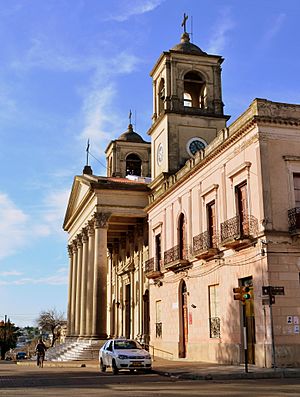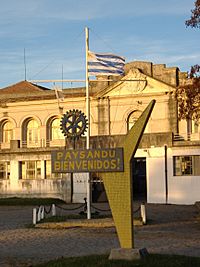Paysandú facts for kids
Quick facts for kids
Paysandú
|
|
|---|---|
|
Capital city
|
|

Basílica as seen from 18 de Julio street
|
|
| Country | |
| Department | |
| Founded | 1756 |
| Elevation | 34 m (112 ft) |
| Population
(2011)
|
|
| • Total | 76,412 |
| Time zone | UTC −3 |
| Postal code |
60000
|
| Dial plan | +598 472 (+5 digits) |
| Climate | Cfa |
Paysandú (Spanish pronunciation: [pajsanˈdu]) is the capital of Paysandú Department in western Uruguay.
Contents
History
It was founded in October 1756 and had acquired the status of "Villa" (town) before the independence of Uruguay. On 8 June 1863, its status was elevated to "Ciudad" (city) by the Act of Ley Nº 780.
General Leandro Gomez led Uruguayan forces to save the town from an invasion by Brazilian forces in 1864–1865. A battle took place on 2 December 1864.
Population
In 2011 Paysandú had a population of 76,412. It is the fourth largest city in Uruguay, after Montevideo, Salto and Ciudad de la Costa.
| Year | Population |
|---|---|
| 1908 | 20,953 |
| 1963 | 51,645 |
| 1975 | 62,199 |
| 1985 | 68,466 |
| 1996 | 74,568 |
| 2004 | 73,292 |
| 2011 | 76,412 |
Source: Instituto Nacional de Estadística de Uruguay
Paysandú is more cosmopolitan than most Uruguayan cities, with many settlers from Italy, Switzerland, Poland, Germany, Russia, Ukraine, Belgium and various African nations.
Geography
The city is located on the banks of the Uruguay River, which forms the border with Argentina. It lies 378 kilometres (235 mi) northwest of Montevideo via Route 1 and Route 3, on the junction of the latter with Route 90. As of the census of 2011 it was the fourth-most populated city of the country.
A small distance north of the city is the General Artigas Bridge that links Uruguay with the Entre Ríos Province of Argentina, south of the city Colón.
Climate
Paysandú has a humid subtropical climate, described by the Köppen climate classification as Cfa. Summers are warm to hot and winters are cool, with the occurrence of frosts and fog. The precipitation is evenly distributed throughout the year, although winters are slightly drier, with an average of 1,181 mm (46.5 in), and the annual average temperature is around 19 °C (66 °F). On 20 January 1943, Paysandú recorded a temperature of 44.0 °C (111.2 °F), which is the joint highest (along with Florida) temperature to have ever been recorded in Uruguay. The lowest temperature to have ever been recorded in Paysandú is −7.4 °C (18.7 °F) in June.
| Climate data for Paysandú, Uruguay (1991–2020, extremes 1937–2020) | |||||||||||||
|---|---|---|---|---|---|---|---|---|---|---|---|---|---|
| Month | Jan | Feb | Mar | Apr | May | Jun | Jul | Aug | Sep | Oct | Nov | Dec | Year |
| Record high °C (°F) | 44.0 (111.2) |
42.4 (108.3) |
39.4 (102.9) |
36.0 (96.8) |
33.0 (91.4) |
29.8 (85.6) |
30.6 (87.1) |
33.8 (92.8) |
36.4 (97.5) |
38.0 (100.4) |
41.5 (106.7) |
42.0 (107.6) |
44.0 (111.2) |
| Average high °C (°F) | 31.7 (89.1) |
30.1 (86.2) |
28.5 (83.3) |
24.6 (76.3) |
20.4 (68.7) |
17.6 (63.7) |
17.0 (62.6) |
19.6 (67.3) |
21.2 (70.2) |
24.1 (75.4) |
27.7 (81.9) |
30.2 (86.4) |
24.4 (75.9) |
| Daily mean °C (°F) | 25.1 (77.2) |
23.9 (75.0) |
22.4 (72.3) |
18.9 (66.0) |
15.4 (59.7) |
12.6 (54.7) |
12.0 (53.6) |
13.9 (57.0) |
15.4 (59.7) |
18.4 (65.1) |
21.3 (70.3) |
23.7 (74.7) |
18.6 (65.5) |
| Average low °C (°F) | 18.5 (65.3) |
17.8 (64.0) |
16.3 (61.3) |
13.3 (55.9) |
10.4 (50.7) |
7.7 (45.9) |
7.0 (44.6) |
8.2 (46.8) |
9.7 (49.5) |
12.6 (54.7) |
14.8 (58.6) |
17.1 (62.8) |
12.8 (55.0) |
| Record low °C (°F) | 7.8 (46.0) |
3.2 (37.8) |
3.2 (37.8) |
0.0 (32.0) |
−2.6 (27.3) |
−7.4 (18.7) |
−6.6 (20.1) |
−4.0 (24.8) |
−3.4 (25.9) |
0.0 (32.0) |
2.3 (36.1) |
4.8 (40.6) |
−7.4 (18.7) |
| Average precipitation mm (inches) | 141 (5.6) |
136 (5.4) |
112 (4.4) |
154 (6.1) |
109 (4.3) |
72 (2.8) |
55 (2.2) |
75 (3.0) |
79 (3.1) |
121 (4.8) |
105 (4.1) |
132 (5.2) |
1,291.7 (50.85) |
| Average precipitation days (≥ 1.0 mm) | 7 | 7 | 6 | 7 | 6 | 5 | 5 | 5 | 6 | 8 | 6 | 7 | 75 |
| Average relative humidity (%) | 62 | 67 | 70 | 75 | 77 | 78 | 74 | 72 | 71 | 70 | 67 | 63 | 71 |
| Mean monthly sunshine hours | 285.2 | 226.0 | 232.5 | 198.0 | 186.0 | 153.0 | 173.6 | 192.2 | 201.0 | 229.4 | 255.0 | 279.0 | 2,610.9 |
| Mean daily sunshine hours | 9.2 | 8.0 | 7.5 | 6.6 | 6.0 | 5.1 | 5.6 | 6.2 | 6.7 | 7.4 | 8.5 | 9.0 | 7.2 |
| Source 1: Instituto Uruguayo de Metereología | |||||||||||||
| Source 2: Instituto Nacional de Investigación Agropecuaria (humidity and sun 1980–200) | |||||||||||||
Economy
The main industries in the city are Norteña brewery, Azucarlito (sugar), Paylana (which is a producer of world-class woolen fabrics), and Paycuero (leather). Paysandú is also the centre of plantation forest industry in Uruguay, with many companies involved in the planting and harvesting of Eucalyptus plantations.
Transportation
The city is served by Tydeo Larre Borges International Airport.
Recreation
Paysandú has some fine recreational beaches on the Uruguay River which have lifeguards during the summer. It is also home to many sporting clubs, including a rowing club, yacht club, and numerous others for football, rugby, hockey, tennis and polo.
Education
Previously the area had a German school, Deutsche Schule Paysandú.
Also the city has a Center of the University of the Republic (Centro Universitario de Paysandú).
Places of worship
- Parish Church of Our Lady of the Rosary and St. Benedict of Palermo (Roman Catholic)
- St. Raymond and St. John Bosco Parish Church (Roman Catholic, Salesians of Don Bosco)
- Sacred Heart of Jesus Parish Church (Roman Catholic)
- St. Joseph the Worker Parish Church (Roman Catholic)
Notable people
Politicians
- Reinaldo Gargano (FA), Foreign Minister of Uruguay (2005–2008) †
- Jorge Larrañaga (PN), current Senator
- Raúl Sendic (FA), Vice-President of Uruguay 2015–2017
Football players
- Sebastián Soria, Qatari football player
- Walter Gargano, football player of Peñarol
- Nicolás Lodeiro, football player of Seattle Sounders FC
- Bosco Frontán, retired footballer who played mostly in Uruguay and Mexico
- Egidio Arévalo Rios, the 10th most capped player for Uruguay with 91, currently with Correcaminos UAT
- Maxi Gómez, football player of Trabzonspor
- Marcelo Saracchi, football player of Levante
Musicians
- Los Iracundos
- Alfredo Eusebio Gobbi, tango musician
Other
- Clotilde Luisi (1882–1969), first woman to study law at the University of the Republic
- Ricardo Armentano, professor and researcher of international repute
- Hiber Conteris (1933-2020), literary critic and playwright
Twinned cities
- Hellín, Spain
- Muscatine, Iowa, United States
- Smara, Western Sahara
See also
 In Spanish: Paysandú para niños
In Spanish: Paysandú para niños
- List of diplomatic missions in Uruguay#Consulate in Paysandú



